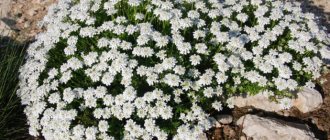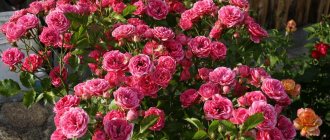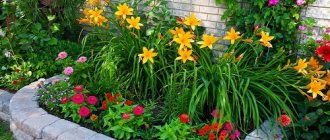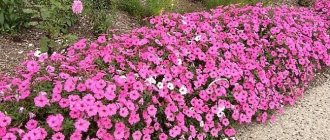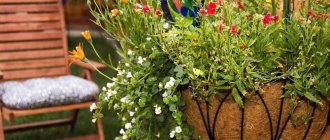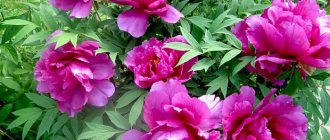Planting flowers as seedlings allows you to increase seed germination. Because thanks to such greenhouse conditions, plants can grow stronger and gain strength. The methods chosen for growing flower seedlings should be based on the basic requirements for the development of specific plants. This method is often used for annual plants.
Brief overview of the article
Flower seedlings in February
Garden plants that require seedlings to grow include the categories of heat-loving and capricious flowers. There is also no uniformity in the timing when it is necessary to plant seeds. Therefore, when asked about where to get seedlings for flowers, beginners often have no other thought than to go to the nearest gardening store to get them.
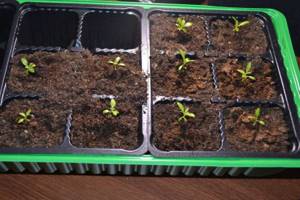
Although everything is far from so scary, and many flowers grow almost independently. You just need to know when and what needs to be planted. For example, in February they begin to plant azarina, pansies, begonia, carnations, which are considered Chinese, lobelia, nirembergia, petunia, purslane, and salvia.
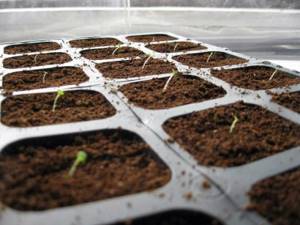
Bulbous flowers in the country
When choosing bulbous plants for decorating a garden or summer cottage, you need to focus on the composition of the soil, lighting in the growing area, neighboring crops, and flowering dates. If the conditions are not suitable, then the formation of buds may not wait.
Bulbous flowers for the garden: names and varieties
Blooming in spring
Flowers blooming in early spring will decorate the area waking up from winter sleep, and a little later they will create bright spots among the few spring colors. To avoid damaging the bulbs when digging, you need to draw up a planting plan or mark the location with special signs.
Related article:
What bulbs can be grown in the garden?
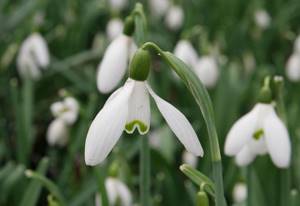
What to plant:
- Galanthus or snowdrop - blooms in early spring in thawed areas, drooping delicate white flowers and dark green narrow leaves look beautiful among last year's foliage, height 10-12 cm;
- Iridodictium (reticulated iris) - blooms in March, loves the sun and does not tolerate excess moisture;
- Spring crocus or saffron - milky cream or soft purple drooping flowers appear in April, the stems are low (12-15 cm), the leaves are bright, emerald;
- Lily of the valley - loves shady places, is unpretentious, blooms in April-May with small white flowers;
- Muscari or mouse hyacinth - racemose or cone-shaped inflorescences from white to dark blue appear in April-May, height - up to 30 cm;
- Narcissus – blooms from mid-April, single flower;
- Tulip - flowering time, color, height depend on the variety;
- Scilla - undemanding to light, white or blue flowers appear in March;
- Chionodoxa Lucilia - flowering begins immediately after the snow melts, height does not exceed 10 cm, the flower looks like a lilac-lilac bell;
- Erantis - grows quickly, white or golden buds appear on low bushes in March-early April.
Related article:
Viola - how to plant and grow pansies correctly
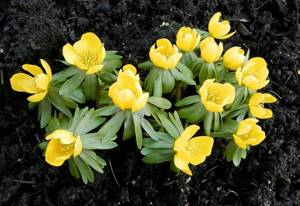
Summer bulbous
Bulbs that bloom in summer add color and enliven shady areas. To prevent the flower garden from becoming bare, you need to choose the right flowers, having familiarized yourself with the flowering dates in advance:
- Garden begonias - distinguished by a variety of shapes and colors of flowers, abundant flowering;
- Brodiea - loves sunny places, flowers that look like pink, lilac stars appear in June;
- Galtonia is a tall bush (up to 1.5 m), drooping inflorescences bloom in late summer or early autumn, loves the sun;
- Ixia - planted in light areas protected from the wind, height reaches 50-70 cm, inflorescence is spike-shaped, bright;
- Lilies, decorative onions - are represented by a wide variety of varieties with different flower colors and flowering periods;
- Montbrecia - the inflorescence resembles a wheat spikelet of orange, red, yellow color, blooms in July-August, loves the sun, grows quickly;
- Freesia - fragrant flowers of different colors bloom in July-August.
Related article:
Flowering vines: a universal garden decoration
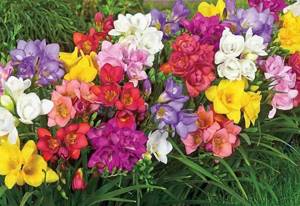
Autumn-flowering
Among the bulbous plants there are those that bloom in autumn. They are distinguished by their special elegance and originality:
- Colchicum or autumn crocus - the bulk of large beautiful buds appear in September-October, loves bright places;
- Garden cyclamen - loves partial shade, grows like a carpet, bright flowers have a pleasant aroma;
- Sternbergia - bright yellow crocus-like flowers appear in September and early October.
Features of planting February seedlings
Since February is a winter month, it is characterized by a lack of sunlight and lower temperatures. When planting flowers, you should take care of their additional lighting, the presence of stable temperature indicators, and in some cases, maintaining the required percentage of humidity. Without these conditions, seedlings may not only be very weak, but may also not survive to the dacha plot.
Ground cover or creeping
In ornamental gardening, there is a group of low-growing (no more than 30 cm) plants that can actively take over the nearby territory. They do not allow weeds to grow, are decoratively stable, protect the soil from being washed away and blown away, therefore they are actively used in personal gardens, gardens and summer cottages.
Popular ground cover flowers:
- Arabis - blooms profusely all summer, forms clumps with a diameter of 30-40 cm, color depends on the variety;
- Aubrecia is a long-flowering (up to 45 days), low (10-13 cm) plant with small white, blue, purple flowers;
- Periwinkle is decorative due to its bright blue flowers and dark green shiny leathery leaves that retain their rich color until winter;
- Loosestrife - blooms profusely all summer, the creeping stem is densely covered with leaves, the flowers are yellow;
- Veronica - bright blue, pink, blue, white flowers look like a spikelet, the length of the stems is about 40 cm, blooms from June to the end of summer;
- Nasturtium - the size of the flowers, the length of the stems, and the duration of flowering depend on the variety;
- Aubrietta - flowers of different colors, form beautiful dense clumps;
- Phlox subulate is a very original, beautifully flowering, low (10-15 cm) evergreen plant.
Related article:
Unpretentious perennials that bloom in the first year - which seedlings should I plant in January?
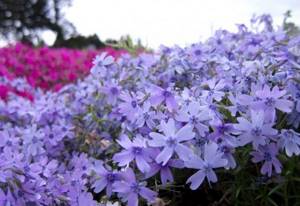
Some varieties of ground covers are grown as canopy flowers and planted to decorate fences and buildings.
Interesting: Garden flowers of purple hue
Flower seedlings in March
March is the most common month for planting seeds for seedlings. It is worth noting. that if it was not possible, for example, to plant petunia in February, then you can do it in March, then it may bloom a little later.
In the first spring month, ageratum, amaranth, asters, fragrant tobacco, gillyflower, snapdragon, mimulus, and drummond phlox are planted. The most important thing for March seedlings is compliance with watering rules, availability of lighting, and maintaining a temperature comfortable for the plants.
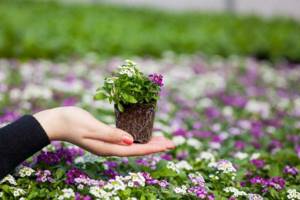
In some cases, seedlings of annual flowers can be planted in April, but these should be fast-growing varieties that can be replanted in a month. Such plants include marigolds, annual dahlia, sweet peas, morning glory, cineraria, zinnia.
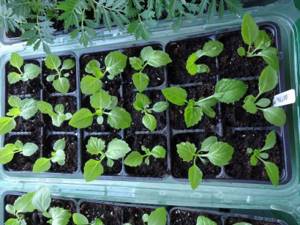
Seedlings of annual flowers - growing rules
In areas with cold winters, late spring, and unstable weather, the seedling method pays off - by the time the return frosts end, you can get an adult plant ready to flower. It also makes it possible to control and adjust the development of seedlings at different stages, saving financial and physical costs, since you can grow as many seedlings as required.
Related article:
Weigela: types, cultivation, planting and care in open ground
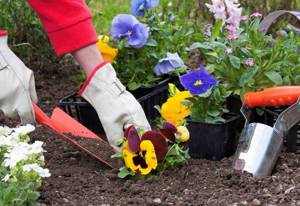
The seedling method is necessary if:
- cold resistance is low – the crop cannot tolerate temperatures below +5 °C;
- germination requires constant high temperature and bright light;
- the flowering period is long;
- the duration of the growing season is long;
- it is necessary to accelerate the onset of flowering.
Interesting! What annuals to plant in the country
Selection and preparation of containers
The volume of containers depends on the number of seedlings. If there is a lot of it, then in order to save space and ease of movement, at the initial stage they are sown in large low containers (5-6 cm), for example, boxes, milk cartons, pieces of wide plastic pipes, cut lengthwise. It is better not to take tall boxes - diving from them is inconvenient. Metal pans and tin cans are also not suitable - the soil in them can oxidize.
Related article:
Tall perennials for the shade garden
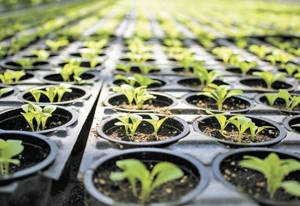
A small number of seedlings, in order not to dive in the future, are planted immediately in plastic cups (500 ml), peat tablets, plastic bottles cut to height, and milk cartons. Holes must be made in the bottom to drain excess moisture. The same containers can be used for picking seedlings from large boxes. Any utensils that have been previously used must be washed, scalded with boiling water or disinfected with a manganese solution.
The soil
The soil mixture from under indoor plants or other seedlings cannot be used - it may contain bacteria, fungal spores and other pathogens. It is also not recommended to take garden soil, since it retains insect larvae and pathogenic microorganisms.
It is best to purchase ready-made soil suitable for all types of flower plants - it is loose, moisture- and breathable, and contains the required amount of microelements. If possible, preparing the mixture yourself is not difficult.
Related article:
Acidify the soil for hydrangea
Soil mixture options:
- leaf and turf soil + humus + sand (equal shares);
- turf soil (3 parts) + sand, peat (1 part each).
The components are mixed, disinfected - poured with boiling water or a pink solution of manganese. After the soil has dried, you can fill the containers and start sowing.
When choosing soil, you need to rely on the characteristics of the plant. For example, aster, ageratum, snapdragon will prefer a mixture without humus, since they are prone to fungal infection “black leg”.
Sowing rules
The method of planting annual seedlings depends on the size of the seeds - large ones are planted in holes, furrows three times the length of the seed, for not very large furrows smaller - no more than 0.5 cm. Medium-sized seeds are sometimes simply scattered and covered with earth (layer 0 .5 cm). The fine seed is not covered with soil - it is mixed with fine sand, evenly distributed over the surface, moistened with a spray bottle, and covered with film.
Related article:
Cuttings of roses - a simple way of vegetative propagation
Procedure:
- pour a layer (0.8-1 cm) of drainage from small crushed stone, gravel, expanded clay, broken brick onto the bottom;
- fill with soil mixture, leaving 1.5-2 cm to the edge, water with warm, settled water;
- when the soil settles, water again and wait until the moisture is absorbed;
- if necessary, make grooves;
- spread out the seeds, cover with dry soil or sand, spray with a spray bottle;
- cover with transparent film and place in a warm (20-24 °C) bright place;
- keep the soil moist.
Care
The film is removed after germination; the seedlings are kept in the same room until they become stronger. Then they are transferred to where it is light and the temperature is slightly lower (18-20 ° C), there are no drafts or direct sun. If there is a lack of natural light, install lighting - otherwise the seedlings will stretch out and weaken.
Related article:
What are hydrangeas?
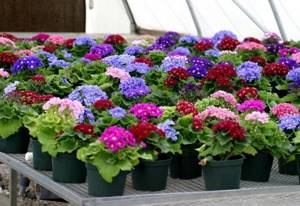
How to care:
- Watering . Water at the root, moderately, in small portions, using settled water heated to room temperature. The signal for watering is dried out soil in the top layer. Excess moisture leads to rotting of the still weak roots.
- Picking . In the case of using individual containers and peat tablets, diving is not carried out. From common to individual seedlings, they are transplanted if they have 2-4 true leaves. The long central root is pinched off when transplanting. For several days after the procedure, the plants are kept in a shaded room.
- Fertilizer application . The first time is fed with mineral fertilizers (according to the instructions) or mullein (1:10 solution) a week after the dive, the second time - 1.5-2 weeks after the first. The second feeding consists of a mixture of solutions of ammonium nitrate and superphosphate - 1 g/1 l and 2 g/1 l, respectively. Fertilizing is completed by watering with clean water.
- Hardening . 1.5-2 weeks before transplanting into the ground, they begin to harden the seedlings. Heat-loving crops are placed on an open veranda or balcony at a temperature not lower than +12 °C, cold-resistant crops - at +8 °C. At first, the session lasts no more than two hours, then the time is gradually increased to several hours. If it is not possible to carry out the seedlings, then open the window, but without drafts.
- Transplantation into the ground . Seedlings of heat-loving annual flowers (petunia, zinnia, aromatic tobacco, verbena) are planted in a ridge or flowerbed when positive daytime temperatures are above 14 °C and return frosts are no longer a concern. Cold-resistant varieties (Shebo carnation, gillyflower) are planted earlier because they can withstand frosts down to -5 °C. It is better to replant in the evening or on a cool cloudy day.
Related article:
What flowers can be sprayed with succinic acid
Rules for the formation of seedlings
It is important to prepare the seeds. If we are talking about purchased seeds, they are already completely ready for planting. In the case where the seeds were collected independently, it is necessary to remove all debris remaining on them.

Stratification is important for some types of seeds, namely a kind of imitation of conditions equivalent to winter ones. To do this, all peeled seeds are put in the refrigerator for a month.
This procedure is especially important for aster seeds, lavender seeds, and for seeds of various coniferous species. It is also important to disinfect the self-collected seeds; to do this, they are soaked in a solution of potassium permanganate. Scarification is also possible for more intensive germination of the hardest seeds.
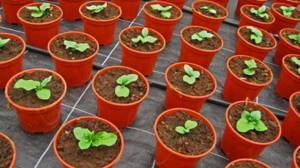
It is necessary to prepare the soil for seedlings, as well as containers. It is advisable to use specialized types of soil.
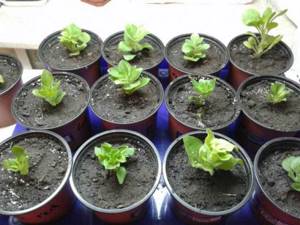
The seeds are sown directly into the prepared containers. Moreover, they need to be sown differently. The first method is surface sowing, and the second is to create preliminary depressions for planting seeds in them.
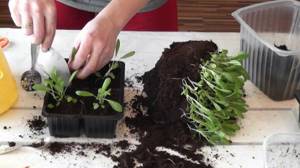
Planting flowers in flowerbeds and containers
A composition of regular geometric shape - in the form of a circle, square, polygon - is usually intended for all-round viewing. Flowerbeds are placed in the front parts of the garden, for example at the entrance to the house. Therefore, it is important that they attract attention throughout the season.
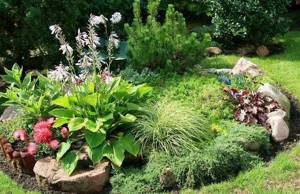
For planting plants in the garden in a flower bed, preference is usually given to summer flowers that bloom from spring to autumn, sometimes changing the composition: until June 10-15, the flower garden is decorated with bulbs planted in the fall or viola, which is planted in mid-May.
These plants are not afraid of spring frosts. At the beginning of summer, cold-resistant flowers are replaced by heat-loving summer flowers, and flowering continues until autumn.
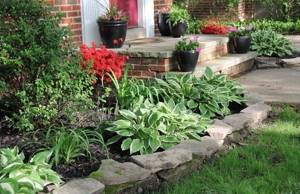
Containers are used where it is impossible to create permanent flower beds - in areas with hard surfaces, on balconies.
This is a very practical idea for planting flowers to decorate a plot, allowing you to create mobile compositions and change the appearance of the garden at the owner’s discretion. Not all plants are suitable for such plantings.
First of all, we need drought-resistant crops - the soil in a container dries out much faster than in a traditional flower garden. Plants with wide leaves that consume a lot of moisture are not suitable for such plantings. The best choice is compact plants or their varieties that have a beautiful shape—spherical, pillow-shaped, or ampelous.
As shown in the photo, when planting garden flowers in a massive container, you can place a fairly large and “ankle-legged” plant in the center, decorating its lower part with a “skirt” of lush summer flowers:
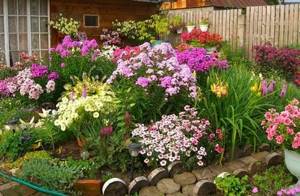
What to do if you want to get a beautiful front garden on your summer cottage, but you don’t have the time or energy to care for it? The article is devoted to describing the most popular crops among “lazy” gardeners. Have a hassle-free summer!
Rules for picking seedlings
Plants begin to peak, as a rule, after the first two leaves have formed. Since during this period there is a reorganization and transition to feeding the plant directly from the root. But, at the same time, the root system has not yet grown much, so their injury during transplantation will be minimal.
The exception to this approach is lobelia. To dive it you need to wait for at least four leaves. Using a spatula, pry up the sprout, which has been well watered beforehand, and carefully pick up the accompanying soil, after which it is placed in another pot prepared in advance.
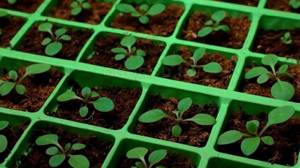
It is advisable to place such transplanted seedlings in the warmest possible place and water them well.
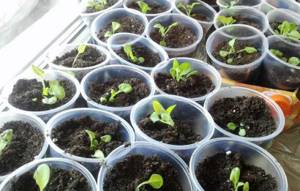
Curly (braiding)
If the area of the plot is small, then climbing plants will help out; they can be planted near fences, buildings, trees, and gazebos. With their help, they zone the territory and hide unsightly outbuildings. They take up little space and are unpretentious.
Annuals:
- Azarina (ampeloid gloxinia) - blooms until frost, lilac, pale purple, purple flowers, similar to a megaphone, tubular, large (4-5 cm);
- The vine is decorated with small tubular bright flowers collected in a loose cluster and doubly pinnate leaves; the flowering is abundant and long-lasting;
- Sweet peas – the flowers are fragrant, large (3-8 cm), if you cut off the fruit pods, they bloom until the cold weather;
- Morning glory tricolor - a beautiful heart-shaped leaf, the diameter of the funnel-shaped flower reaches 8-10 cm, the color is blue, violet, blue;
- Kvamoklit - a beautiful leaf, dissected, bright green, white or red flowers are small, similar to a small gramophone;
- Kobeya climbing - a purple fragrant flower shaped like a large bell; several vines planted nearby form a dense hedge that protects from wind and sun;
- Momordica - the vine is decorated with bright orange oblong-shaped fruits;
- Thunbergia winged - forms a thick vertical carpet strewn with bright orange-yellow flowers.
Related article:
Ampelous petunias: 7 beautiful varieties that will bloom all summer
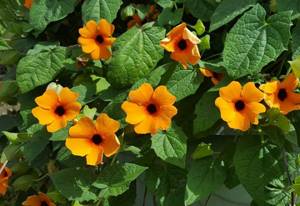
Annual climbing garden flowers are grown in boxes, flowerpots, and containers. They can be moved from place to place, changing the design of the area, and used to decorate balconies, terraces, and porches.
Perennial:
- Wisteria - the flowers are large, hanging, they are white, lilac, violet, lilac, blue, the leaf is green in summer, turns yellow in autumn;
- Climbing honeysuckle (varieties Honeysuckle, Brown) - beautifully entwines fences, low arches, arcs, bright flowers in bunches are located in the axils of bright green oval leaves;
- Campsis grandiflora - forms dense thickets; clusters of bell-shaped flowers of various shades of orange look beautiful against the background of bright green leaves;
- Clematis - do not tolerate excess moisture well, do not like direct sun, bloom profusely, the flowers are large, bright, of different shapes and colors;
- Prince Siberian or wild hop is an unpretentious plant, covers any surface, flowers are white, pink, purple;
- Roses (Wartburg, Dortmund, Ilse Crown Superior, Flammentan, Bobby James) - beautifully entwined around the supports, bloom profusely and for a long time both in the sun and in partial shade;
- Hops - the length of the vine reaches 10-12 m, on the female plant inflorescences are formed that look like a cone - light in color, they contrast beautifully with the green leaves.
Related article:
10 Best Flowers for Beginner Gardeners' Flowerbeds

Perennial vines are usually unpretentious; most can withstand temperature changes. To maintain decorativeness, some varieties require pruning.
Seedlings in peat tablets
Peat tablets are a convenient way to avoid picking for particularly capricious flower crops. They are peat, which is compressed in a certain way, and when water gets in, it begins to swell and grow upward, while the diameter of such tablets remains the same.
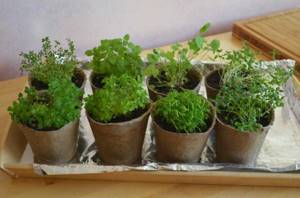
After the leaves appear, the plant is replanted with such a tablet, which is a very convenient approach for those who do not have the necessary experience in plant picking.
Sowing calendar
The lunar calendar for planting flowers for 2021 is presented in the table:
| Month | Favorable days for planting annual flower seeds | Favorable planting days for perennial flowers (bulbous, tuberous, root-propagated) | Unfavorable sowing and planting dates |
| January | 5, 6, 9, 27, 28, 29 – any; 2, 3, 4, 30, 31 – with spines and red-orange; 7, 8 – ampelous and tall | 14, 15, 20, 21 – tall; 11, 16, 18, 19, 22, 23, 24 – the rest; | 10, 12, 13, 25, 26 |
| February | 1, 2, 3, 6, 7, 24, 25, 28, 29 – any; 4, 5 – ampelous and tall; 26, 27 – with spines and red-orange | 10, 11, 16, 17, 18 – tall; 12, 13, 14, 15, 19, 20 – the rest; | 8, 9, 21, 22, 23 |
| March | 2, 3, 29, 30, 31 – ampels and high ones; 25, 26 – with spines and red-orange; 1, 4, 5, 6, 27, 28 – all others | 10, 15, 16 – tall; 11, 12, 13, 14, 17, 18, 22, 23 – the rest | 7, 8, 9, 19, 20, 21, 24 |
| April | 1, 2, 7, 24, 28, 29 – any; 5, 6, 25, 26, 27 – ampelous and high | 11, 12 – tall; 20, 21, 22 – red, orange; 9, 10, 13, 14, 18, 19 – the rest | 3, 4, 8, 15, 16, 17, 23, 30 |
| May | 2, 3, 23, 24, 30, 31 – ampelous and high; 4, 5, 6, 25, 26 – the rest | 8, 9, 10 – tall; 18, 19 – red, orange; 11, 12, 15, 16, 17, 20, 21 – the rest | 1, 7, 13, 14, 22, 27, 28, 29 |
| June | 1, 2, 3, 4, 22, 23, 28, 29, 30 – any; 26, 27 – ampels and highs | 14, 15, 16 – red, orange; 6, 19, 20 – tall; 7, 8, 12, 13, 17, 18 – the rest | 5, 9, 10, 11, 21, 24, 25 |
| July | 1, 4, 25, 26, 27, 28 – any; 2, 3, 23, 24, 29, 30, 31 – ampelous and high | 16, 17, 18 – tall; 11, 12, 13 – red, orange; 6, 9, 10, 14, 15 – the rest | 5, 7, 8, 20, 21, 22 |
| August | 1, 2, 22, 23, 24, 25, 28, 29 – any; 20, 21, 26, 27 – ampelous and high | 13, 14 – tall; 8, 9 – red; 5, 6, 7, 10, 11, 12, 15, 16 – the rest | 3, 4, 17, 18, 19, 30, 31 |
| September | 18, 19, 20, 21, 24, 25, 29, 30 – any; 22, 23 – ampelous and high | 4, 5 – red; 6, 7, 8, 13, 14 – tall; 3, 9, 10, 11, 12, 13, 16 – the rest | 1, 2, 14, 15, 17, 26, 27, 28 |
| October | 17, 18, 21, 22, 23, 26, 27 – any; 1, 28, 29, 30 – with spines, red-orange; 19, 20 – ampelous and high | 3 – red; 4, 5, 6, 7, 8, 9, 10, 13, 14, 15 – the rest | 2, 11, 12, 16, 24, 25, 31 |
| November | 18, 19, 22, 23, 24, 27, 28, 29 – any; 16, 17 – ampelous and high; 25, 26 – with spines, red-orange | 3, 4, 10, 11 – tall; 1, 2, 5, 6, 12, 13, 14 – the rest | 7, 8, 9, 15, 20, 21, 30 |
| December | 15, 16, 20, 21, 25, 26 – any; 27, 28, 29 – ampelous and high; 22, 23, 24 – with spines, red-orange | 1, 7, 8, 13 – tall; 2, 3, 4, 9, 10, 11, 12, 31 – the rest | 5, 6, 14, 17, 18, 19, 30 |
Related article:
Transplanting and dividing lilies
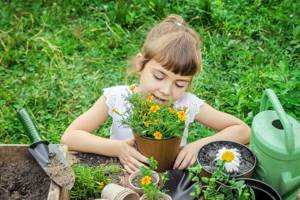
The calendar for sowing flower seeds does not include neutral days, which do not have any effect on flower crops. During these periods, it is better not to sow or plant, but to cultivate the soil, plant seedlings and carry out other agrotechnical activities.
What does sowing in snow mean?
This method is used for the smallest seeds that do not require deepening when planted in the soil. In this case, take containers into which soil is placed, and a couple of centimeters of ordinary snow on top. In this case, it turns out that the soil is naturally nourished by melt water, which contributes to the rapid germination of seeds.
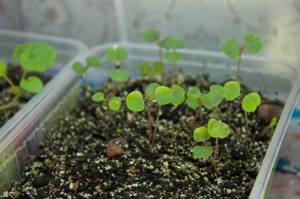
It is imperative that such a container be covered to form a certain temperature there, which will promote better germination. Periodically, such a cover must be removed and the plants sprayed.
Pros of annuals
Each plant planted in a garden plot or local area has its own advantages and its own role in the design. Perennials are advantageous because they are less demanding in terms of care, they grow in one place for several years and there is no need to plant annually; various “long-lasting” compositions can be created on their basis.
Related article:
5 varieties of Fallopia for your garden: Secrets of cultivation
Annuals have other advantages:
- a large selection of plants with different flowering periods, flower colors, growing conditions;
- seed material can be harvested independently;
- many reproduce by self-sowing;
- grown by seedlings and without seedlings, while most perennials are best grown by seedlings with mandatory seed stratification;
- sprout quickly after sowing - within 7-10 days;
- with their help, the design of the site is changed annually;
- allow you to fill “voids” in the area without damaging garden plants;
- attract pollinating insects;
- There are many options for use - for cutting, designing paths, ridges, terraces, gazebos, flower beds, creating bright accents, container gardens, decorating unsightly buildings, fences;
- can be combined with garden and garden crops, whereas neighbors for perennials must be chosen carefully;
- bloom quickly, most bloom until cold weather;
- do not require fertilizing if the soil is fertilized during planting;
- The soil is dug up annually, weeds are removed, and fertilized, which is important in preserving fertility.
Related article:
How to plant petunia with cuttings
Seedling care
It is important to water the seedlings in a timely manner, feed them, and pinch them if necessary, if required by a particular plant. If you follow all the instructions for growing seedlings for future flowers, then in the future the plants will be strong and resistant to temperature changes already in open space.
How to sow annual flowers in a flower bed
After the top layer of soil has thawed, annual flowers that are resistant to low temperatures are planted directly in the flowerbed. For example, the seeds of cornflower, calendula, iberis, cosmos, and nasturtium overwinter well in the ground, so they can be sown in early spring. Before sowing, large seeds can be soaked and sprouted; without sprouts they will take longer to sprout.
Recommendations for planting:
- the garden bed is dug up in the fall, freed from weeds, fertilized, and covered with black film;
- in the spring, snow is removed from the ridge - under the film it will thaw faster;
- the thawed soil is loosened, furrows are made or holes 1-1.5 cm deep are made, and watered;
- lay out the seeds, cover with dry soil or humus, press down a little;
- the bed is covered with film, pressing the edges with bricks and boards;
- if the seeds do not require planting, then they are scattered over a pre-watered bed and tightly covered with film or glass.
Related article:
Rejuvenating a peony bush: planting technique
After emergence of shoots, the film is removed. If necessary, when the seedlings grow older, thinning is carried out. Removed plants with good roots can be transplanted to another location.
Soil for seedlings
Before buying soil, you should definitely pay attention to its expiration date, as this is an important factor for seed germination. It is worth choosing positions that are specifically designed for planting seedlings.
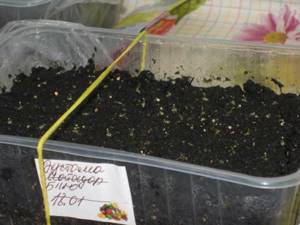
You should not take soil from a garden plot and try to grow anything in it, since purchased soil contains special nutrients that will promote rapid development.
With such a variety of different soils, it is worth paying attention to the composition. The richest and most suitable soil will contain turf, peat and sand. Before filling the soil directly, the bottom of the container should be covered with a small layer of regular sand.
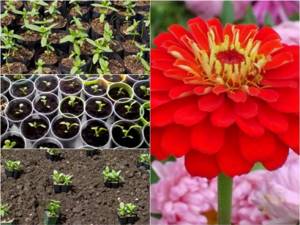
How to plan a flower bed for a beginning gardener?
When planning a flower bed on a summer cottage, it is important to consider the following points:
- Absolutely all plants turn their flowers towards the sun. To avoid “turned away” flowers, you should arrange the flowerbed on the south side.
- When placing a flower bed near a fence, keep in mind that the plants will be visible not only to you, but also to passers-by.
- When sowing flowers in a flower bed, leave space between groups of plants. It’s better to let the flowerbed look free than for spreading flowers to cover their fellows.
- When planning a flower bed, always take into account the type of plants, their height and care conditions. In addition, maintain a distance between flowers of the same type. Flower shoots that are too dense after sowing can be carefully dug up and transplanted to another place. Always take into account the tendency of plants to transplant and choose the most favorable period for this.
- If you come up with the idea of collecting seeds of certain varieties of flowers, do it in advance, without putting it in a long box, because... next weekend the plant may bloom and disperse seeds, or merge with its brothers in the flower garden.
- In order for plants (both annual and perennial) to enjoy their flowering for a long time, faded buds, fruits and ovaries should be periodically trimmed. This promotes faster flower growth and encourages repeat flowering in most plants. For example, lupine, delphinium, and Turkish carnation are best cut after all faded flowers have faded. After pruning, the plants will delight you with repeated flowering.
- Do not sow an entire flowerbed with plants of the same type. When the flowers fade, the area will be empty and will look unsightly.
- There are plants that close in cloudy and rainy weather. Take this detail into account when planning the landscaping of your summer cottage.
- Make it a rule to plant bulbs next to perennials with vigorously growing foliage. In the spring, before the perennials have spread their foliage, the bulbous ones will show themselves in all their glory, then the perennials will cover the drying, faded plants with foliage, thereby preserving the beauty and design of the flowerbed.
- Starting this summer, think about the design of the site for next year. Perhaps you liked your neighbors' flowers and want to grow the same ones next spring. Find out the varieties, care conditions, cost of flowers. Perhaps your neighbors will be happy to exchange some types of plants with you.
